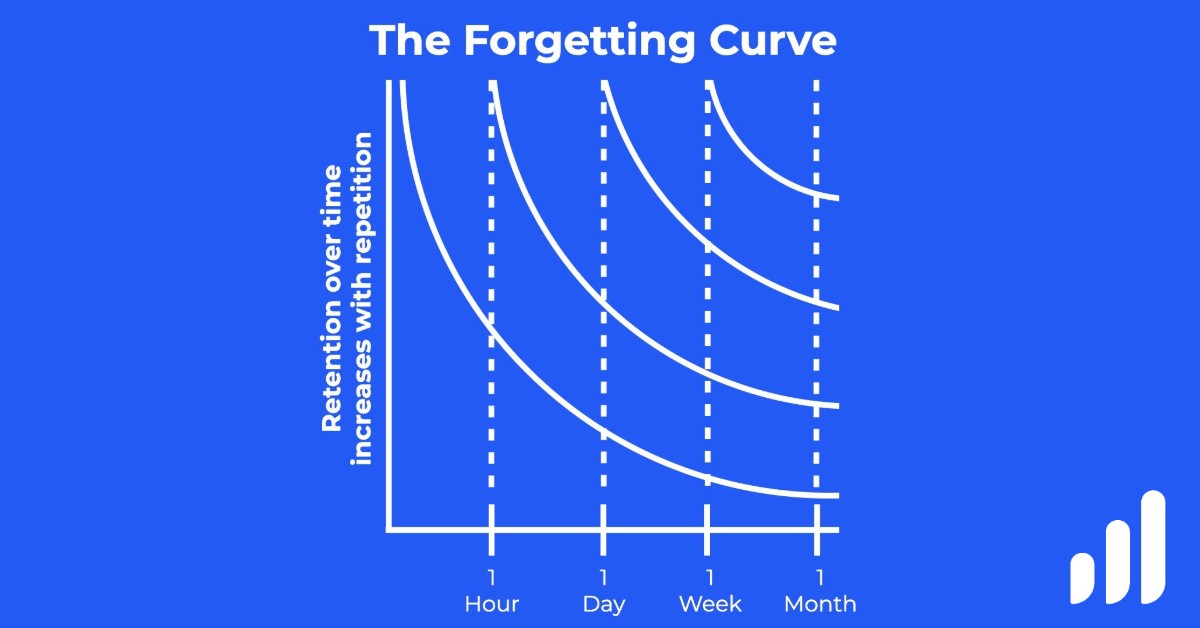
Combating the Forgetting Curve in Online Education
Learners only retain information for so long. How can you help improve their retention rate?
Human memory is a frustratingly fickle thing. You can design an amazing course, and learners can work hard to master the information, but at the end of the day, they have to either use it or lose it.
You are probably already familiar with the forgetting curve from your own personal experience. Basically, we all have good retention of new information in the hours directly after leaning it. But it only takes a day or two for much of that information to leak away, and after a month, we only retain a fraction of what we originally understood.

As in instructor, this can be especially discouraging, as your learners will often judge the success of your course by their own retention. Fortunately, there are many ways you can help learners retain more information. Here are just a few ways to get started.
1. Incorporate frequent reviews and refreshers into your course.
Learning information is mostly a process of helping learners move information from short term to long term memory. For most of us, our brains are highly efficient forgetting machines. We need this, because otherwise we would retain too much unnecessary information. The simplest way to convince our brains that information is important is to reinforce it through repetition.
By testing information shortly after it is learned, and then repeating it throughout a course, learners are better able to store important information in their long-term memory.
2. Take advantage of spaced repetition.
Repetition helps learners remember information, but when it comes to long-term retention, frequency isn’t always best. In fact, learners often retain information best when they are forced to recall it when they’re just on the verge of forgetting it. This is where spaced repetition comes in.
Spaced repetition systems spread out review sessions so that learners don’t over-learn information in the short term, only to forget it over time. Instead, these systems gradually delay reviews over time to optimize the timing of reviews.
3. Make the course content relevant.
The more course content matches personal experience, the better chance learners have of retaining it. Again: our brains are designed to forget irrelevant information. So if we hear something that only seems useful to someone in very different circumstances than our own, we’ll quickly discard it as unnecessary.
But, when that information is connected to our daily experiences, we not only identify with it on an emotional and intellectual level, we’re also more likely to remember it when those similar daily experience arise.
4. Create interactive elements.
Working with course content is another way to make it more personal and relevant. Interaction demands a response, usually in real time. As a result, we create more powerful memories and associations with that information. This is part of why gamified elements of a course have such a positive response with learners. They’re not only fun, they also help learners remember what they learned!
5. Provide a social network.
Personal interaction offers yet another incentive for learners to sit up and pay attention in a course. When learners have the opportunity to discuss content with their fellow learners, it not only helps them work through any questions they might have, it also provides a forum for them to demonstrate their own mastery by helping their course mates. Personal communities also help learners stay accountable for their progress.
6. Mix it up.
Anyone who has ever exercised can tell you the importance of mixing up a workout routine. If you follow the same pattern every session, your muscles grow used to a certain pattern and don’t react as well to exercise outside that norm. Learning can be similar. When you’re planning a test, don’t just include information learned in the most recent lesson. Instead, include information from the entire course. This helps strengthen retention of previous material by making it relevant again, and gives your learners’ brains a better workout.
7. Break your lessons into digestible pieces.
Super long lessons are bad for retention. Not only do learners struggle to retain information overall, they’re likely to have forgotten much of the information at the beginning of the lesson by the time they reach the end. Shorter lessons provide more opportunities for review, and also keep learners from feeling fatigued by too much information.
8. Employ multi-media communication.
Neither a giant wall of text nor a thirty-minute are as effective as a combination of the two. And both can be helped by a good infographic, a short quiz, or a gamified scenario. If you find yourself falling into a pattern with your lessons where they’re all too much of one kind of information, try mixing it up. The variety of learning styles and medias will create stronger associations with your learners, thereby improving outcomes.
9. Push learning content for mobile.
Finally, mobile content offers a compelling opportunity for you to connect with your learners throughout the day. Instead of waiting for your learners to sign in (which they may not do for days at a time), you can push learning content to them on their mobile phones. This will remind them to complete lessons, while offering small, micro learning opportunities to them throughout their day.
Testing will help your learners retain information, but it will also help you see where they help.
Having frequent check-ins with your learners in the form of mini tests not only helps your learners retain information, it also helps you identify areas where your learners need further instruction. So, don’t hesitate to offer short tests between lessons. In fact, you don’t even have to make these for credit. Lowering the pressure on these micro-quizzes can encourage learner participation while helping you monitor their progress and spot sticking points for your learners.

LearnDash Collaborator
@LearnDashLMS






